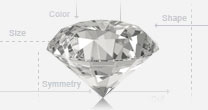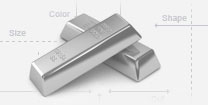- Diamonds
- Engagement
- Jewelry
- Education
- Learn about Diamonds
- Learn about Metals
- What to expect when buying a ring
- Custom Design Process
- The Diamond 4 C's
- How To Care For Your Jewelry
- How To Plan A Wedding
- Picking an Engagement Ring
- Top 10 Ways To Propose
- The Meaning Behind Shapes and Colors of Diamonds
- Advice for Grooms
- The Natural History, Mythology, and Symbolism of Popular Gemstones
- The Bridal Style Checklist
- The Economics of Engagement Rings
- How to Keep Your Diamonds Safe from Theft or Damage
- How to Create the Perfect Christmas Proposal
- The Secret Guide for Authentic Engagement Photos
- How to Plan the Perfect Marriage Proposal
- Best Seasons to Get Married In
- About Us
Diamond Shape Guide
Did you know that the 10 universally recognized diamond shapes that we know today are in fact relatively recent innovations, created and given a theoretic, public platform beginning only in the early 20th century? The 14th century marked the start of European diamond cutting novelties that yielded shapes which, while being the predecessors of today's cuts, are unknown to the modern day diamond consumer: The Point Cut, Old Eight Cut, Pendeloque, Briolette, Rosette, Mazarin and Peruzzi. These advances were in fact the stepping stones to today's 10 contemporary diamond cuts, the global diamond industry's accepted standards.
As part of The Diamond Vault's unfailing commitment to thoroughly educating our customers before, during and after your diamond purchase, we are delighted to present the following diamond shape guide within the scope of our Diamond Learning Center. Each diamond shape has specific and unique characteristics that influence the quality of the diamond. To help you decide what shape best suits your personal taste, take a look below at the different qualities of each distinct diamond shape.
We invite you to look, learn, and marvel. And if you have any questions about diamond shapes, The Diamond Vault welcomes you to Contact Us and speak with one of our experienced customer service representatives.
-

Round
The round brilliant diamond is the most popular and perhaps the most technically advanced of all of the diamond shapes. Only after the development of new diamond cutting technology and a breakthrough in research regarding proportion and symmetry, was the round brilliant born. The round brilliant that we know today was invented by Marcel Tolkowsky, a Belgian mathematician born to a family of diamond cutters who, in 1919, wrote his doctoral thesis on diamond proportion and symmetry, and "invented" the round brilliant. According to his research, the round brilliant, with its 58 facets, has the perfect proportions and symmetry to maximize a diamond's brilliance and fire. This superior quality, therefore, allows for those interested in the round brilliant to be quite flexible regarding the other qualities of their diamond: color, cut and clarity.
-

Princess
The princess diamond is the most popular shape after the round brilliant and is typically square in shape, although it can also be rectangular. The princess shape was created in the 1980s and displays the same high degree of brilliance as the round brilliant. It is a unique and distinctive alternative to the popular round brilliant. It's important to note that when weighing color grades and prices, sometimes a lower color grade diamond in a princess shape will manifest as visible color in the corners of the stone.
What is the ideal cut for a princess diamond?
Princess cut diamonds are the second most popular diamond for engagement rings after round brilliant diamonds, and are valued because of their terrific value and appearance. However, unlike round diamonds, the princess diamond lacks a standardized cut grading, so therefore the GIA or other diamond grading agencies will not grade the cut on a princess diamond.
So, how does one determine the ideal cut proportions for a princess diamond? Like with round brilliant diamonds, the ideal cut for a princess diamond is determined by many factors, most importantly depth and table proportions as well as crown and pavilion angles. The cut is also determined by the symmetrical arrangement of the facets on the diamond, which is simply put, how well all of the facets align with each other in a way that maximizes brilliance and fire.
So what are the ideal proportions of a princess cut diamond? It is our recommendation that for a princess diamond to have ideal proportions, its table must be within 62-68%, the depth must be 64-75% and the crown height should be 10-15%. The symmetry should also be very good to excellent.
Also, another important thing when determining the ideal cut for a princess diamond, it is crucial to take the width to length ratio into account, because this will decide how rectangular or square the diamond is. The ratio is calculated by dividing the length against the width. A perfect square princess diamond will have a ratio of 1, while a more rectangular one will be over 1.05.
When searching for the perfect princess cut diamond, it is always recommended to check with one of The Diamond Vault's certified gemologists who will be happy to suggest some excellent options for ideal princess diamonds.
-

Emerald
The emerald cut is not a brilliant cut, but rather features a large open table with step cuts. The emerald cut is traditionally rectangular and most closely resembles the natural diamond shape. Although the emerald diamond is not as brilliant as the round shape or princess shape, it is considered to be an elegant cut, vintage in style, and less "flashy" than other shapes.
Note that due to the large table of the emerald shape, inclusions and color can be easier to detect. It is recommended that you choose a diamond with a higher clarity and color grade than you would if choosing a brilliant diamond.
-

Asscher
The Asscher diamond is almost indistinguishable from the emerald cut aside from its larger step facets, dramatically cut corners and square shape. Also, because of its proportions, it typically has more light reflection and fire than an emerald shaped diamond. As with the emerald diamond, the Asscher diamond also has a certain antique, elegant air about it. The Asscher diamond, similar to the princess diamond, can sometimes show color impurities in its corners. Therefore, although the price for an Asscher diamond with lower color grade can be enticing, we recommend choosing one with an H color grade or higher.
-

Oval
The oval diamond is a modified round brilliant shape. While this means that it has a high level of brilliance, if the stone is not a premium cut, there is a greater likelihood of the bowtie effect, or a dark strip that appears in the center of the stone in the shape of a bowtie.
-

Marquise
The shape of the marquise diamond was allegedly inspired by the mouth of the beautiful Marquise de Pompadour. It has a football-like shape that comes to a point on either end, which is said to maximize the illusion of increased diamond weight, giving the appearance of a much larger-looking diamond. A modification of the round brilliant, the marquise shape also offers a high level or brilliance and light reflection, and due to its long, lean frame, marquise diamonds are frequently set with side stones.
-

Radiant
The radiant shape was the first diamond of rectangular shape to have a brilliant facet pattern used both for the crown and pavilion, offering a brighter and more brilliant stone than the emerald shape. The radiant shape was born over twenty years ago and is considered to be the father of 'fancy cut' diamonds. The proportioning, facet arrangement and shape of the radiant diamond is considered a good shape for colored diamonds since it is widely held that these factors intensify color.
-

Heart
The heart shaped diamond is a modified brilliant diamond shape and can vary greatly in length and width. The heart shape, with its classic connotation of romance and love, is a popular choice for anniversary rings and Mother's Day necklaces. We recommend that when shopping for a heart shaped diamond you should look for a stone that is perfectly symmetrical: Where the top arches of the heart are even in height and width so that its overall shape is aesthetically pleasing. The cleft in any well-cut heart shaped diamond should be sharp and definite. Also, the heart shaped diamond, similar to the princess shape, can sometimes show color impurities at its corners. Therefore, although the price for a heart shaped diamond with lower color grade can seem inviting, we recommend choosing a heart shaped diamond with an H color grade or higher.
-

Pear
The pear shaped diamond is also a modified brilliant shape, a combination of the round and marquis shapes. It is also known as a teardrop shape for its round bottom and sides which taper to one common point. Some of the world's most famous and most highly graded diamonds have been cut into the pear shape. An elongated pear shape is also considered a specifically flattering shape when worn mounted on a ring with the point facing upwards towards the nail, thus creating an apparent slimming effect of the finger.
-

Cushion
The cushion shaped diamond is technically known as the Old Mine Cut, a shape born before the 1900s. It developed its name due to its similarity to the shape of a pillow and is therefore also known as the "pillow cut". The cushion shaped diamond was one of the most popular diamond shapes before the invention of the round brilliant. Once the round brilliant was developed, the brilliant angles and proportions were incorporated into the cushion shape. The cushion shape has rounded corners and now features larger facets, which increase the brilliance of the stone. It should also be noted that the cushion shape is a popular choice for fancy colored diamonds since the color is displayed evenly throughout cushion shaped diamonds. It should be noted that the large facets of a cushion diamond can make it easier to detect inclusions in the stone. It is therefore recommended that those in the market for a cushion diamond choose a color grade of I or greater and a clarity grade of S1 or higher.










